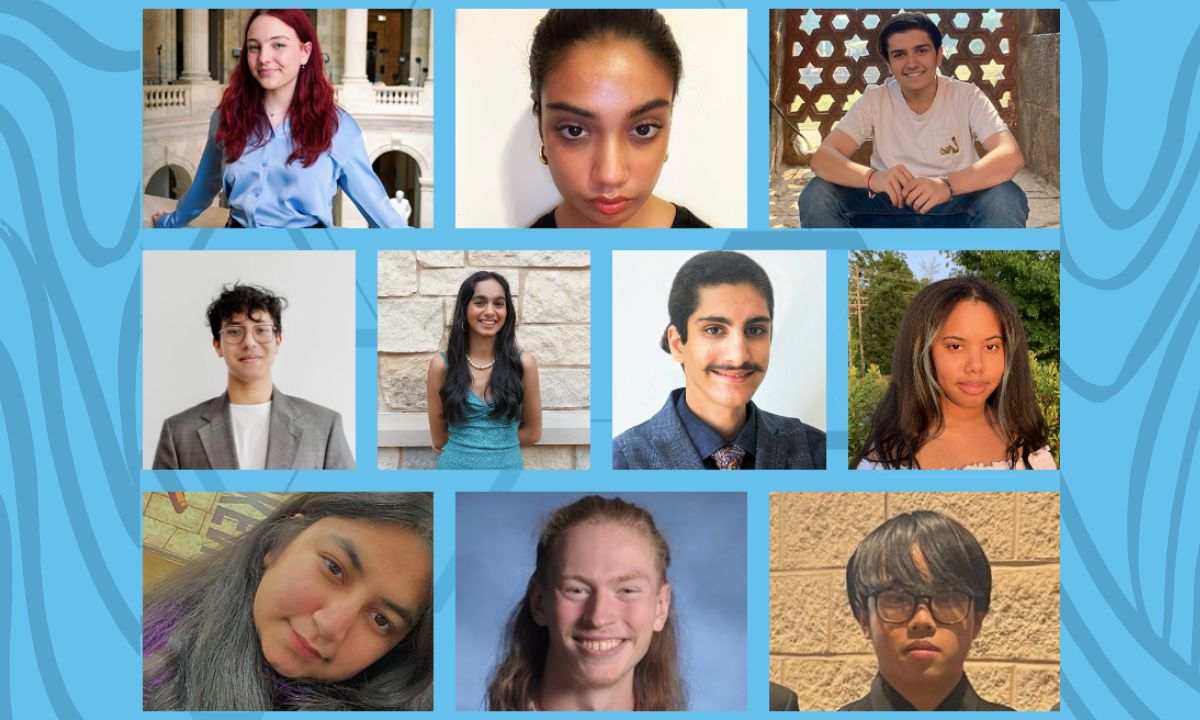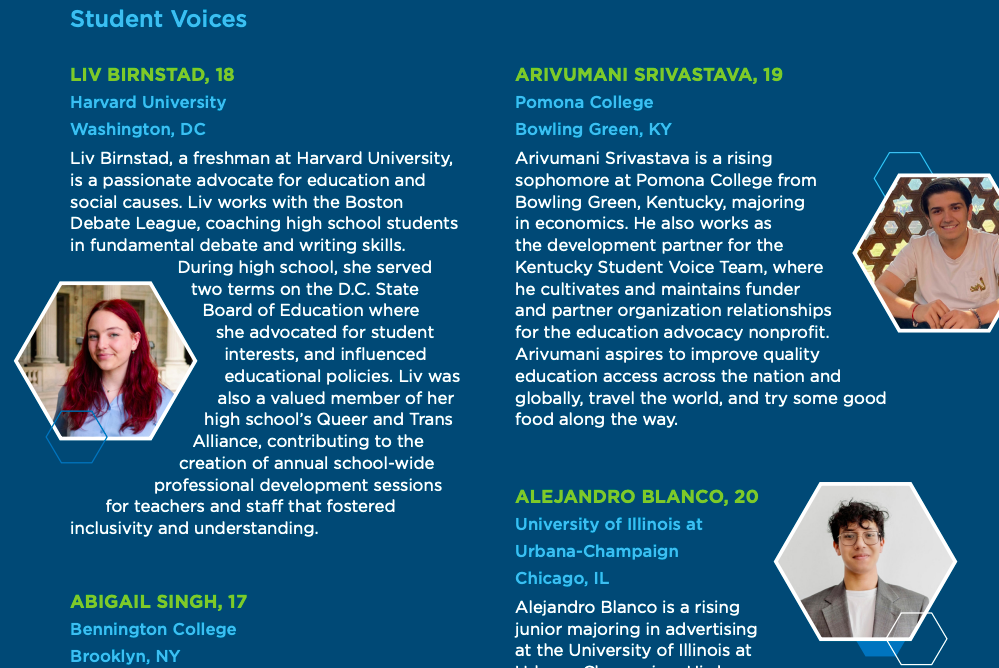To Be a Student in 2023: 10 Teens Open Up About Mental Health, the Age of AI and the Long Shadow of the Pandemic
The Center on Reinventing Public Education’s Cara Pangelinan talked with older youth across the US to get a sense of their immediate recovery needs.

Get stories like this delivered straight to your inbox. Sign up for The 74 Newsletter
This essay was originally published as part of the Center on Reinventing Public Education’s 2023 “State of the American Student” report. As part of the effort, CRPE asked 14 experts from various sectors to offer up examples of innovations, solutions or possible paths forward as education leaders navigate the current crisis. Cara Pangelinan went straight to students to get their opinions — below are some of her key takeaways. (See our full essay series)
Kesar Gaba, a rising sophomore at Queens College, was in high school when the pandemic hit.
“All I saw for two years was black screens on Zoom. It affected my mental health, it affected my relationships within my family, and it really overall affected the way I see the world.”
Arshia Papari, a rising freshman at the University of Texas at Austin, had a slightly different attitude toward online schooling compared to Kesar.
“What the pandemic did for me was that it really opened me up to a new opportunity in schooling, but it also took away the ability for me to do any sort of in-person connections and have a real high school experience. But I think it’s been a trade-off between the experiences you have during high school and also the convenience of online schooling.”
Many students had similar experiences during the pandemic. Whether they enjoyed online schooling or not, these stories have been published dozens of times in varying news outlets and reflected in student surveys. But older students in particular had less time to catch up before leaving the school system, creating concerns as to whether they had ample support emerging from the pandemic.
We at CRPE were interested in learning about these students’ current hopes, fears, and ideas for how to strengthen the U.S. education system. To that end, we spoke with 10 older youth— that is, high schoolers nearing graduation or students who have already graduated—to get their perspective on the data in our report as well as on life as an American teenager, their take on rising mental illness rates among peers their age, and what it would take to change the current education system.
Why the kids are not all right
“If the world around you is giving you stimuli that the world is falling apart or the world’s on fire, and that repeats every day on TikTok or on YouTube … I think that’s what’s leading to the [rising mental health problems] trend of going up, up, up, and up.” –Arshia Papari, rising freshman, The University of Texas at Austin
By now, it is common knowledge that students’ mental illness rates are, and have been, worsening. The pandemic is often blamed. In reality, the pandemic is just part of a bigger picture. Students had concerns around their well-being and safety—both inside and outside of schools—long before Covid-19. The pandemic just created an opportunity to bring these issues to light.
“I feel like the pandemic gave us this gateway to just talk about [feelings of helplessness and depression] in a more normalized setting. This has been a problem for some time, but I don’t think that it’s just because the pandemic happened.” –Abigail Singh, rising freshman, Bennington College, Vermont
Students had a lot to say about what they believe is contributing to these rising trends.
First and foremost, these students are concerned about their safety and security in schools, physically and emotionally. They named political and cultural tensions — Title IX scandals, bans on Pride flags, anti-trans legislation, and reckless gun violence, among others — as harmful to their wellbeing. Even if these events were not happening in their schools or didn’t affect them directly, these issues still impact the mental health of the COVID generation.
Lazuli Clark, a transgender female student, remarked on how difficult it can be to focus on school when some policymakers are passing laws against her identity.
“Going to school is the least of people’s concerns at this point for a lot of people. There are days where I’m like, oh yeah, I have to worry about my AP U.S. history project and yesterday another state basically made it so that I can never exist in that state. And it’s like, how’s anyone supposed to think about anything at all when there’s all of that going on? Even if you’re not directly impacted by it. Most people in my generation know somebody who’s impacted in one way or the other.”
Other students felt vulnerable in their own communities. Liv Birnstad, a recent graduate from a public charter school in Washington, D.C., explained how school resource officers (SROs) were meant to be replaced with mental health professionals in school buildings:
“But what ended up happening is they took [SROs] away and then didn’t replace them [with mental health professionals]. And so now they’re putting [SROs] back into schools because they thought that the problem was that we didn’t have SROs. But the real problem is that we didn’t have inter-community support. At my school we have school resource officers, but we also have a lot of police. And so a lot of students feel really uncomfortable receiving support at school because it feels like a really kind of carceral space.”
Liv is not alone. Arivumani Srivastava, who attended a high school in rural Kentucky, described a similar initiative in his state as a “give-and-take” bill. After the Marshall County High School shooting, the bill mandated a mental health professional be present in schools, but also required a certain number of police officers on campuses. Similarly, Abigail Singh, a graduate of a charter school in Brooklyn, New York, described how it felt to go through scanners at school meant to check for weapons: “It just makes us all feel villainized.”
The students made it clear that in-school mental health supports are not enough to improve their well-being. First, they need to feel safe enough to use these supports.
“If students aren’t able to freely explore themselves in a safe and supported way in schools, then all they’re doing is looking at a future where they’ll have less guidance and probably equal, if not more scrutiny. And so it makes sense for me that they would be hopeless or sad.” –Jaylen Adams, rising freshman, Columbia University, New York
“I feel like mental health is something that we’re still growing in society. We’re advocating on [it] because it is a really big issue that students face. And if it’s not tackled, it just keeps becoming an issue and it could lead to more severe factors on a student’s life. It’s just something that needs to continue to be touched upon in a school setting.” –Alejandro Blanco, rising sophomore, University of Illinois at UrbanaChampaign
Key quotes from students:

Social media: A double-edged sword
We cannot underestimate the influence social media platforms and apps have on youth. For instance, Georgia’s Brady Phan benefited from school closures. He used the free time during lockdown to reflect on his goals and double down on his academic aspirations. But he also saw how school closures adversely affected many of his peers, especially those who were drawn to influential people on social media.
“A lot of these entrepreneurs [on social media] are saying that you should not go to college, that there’s a lot of easier ways to make money. And especially during the pandemic where they’re the most vulnerable–that’s where I see them influence [youth] a lot. And that would maybe change [my peers’] minds about pursuing or excelling in an academic career.” –Brady Phan, rising senior, DeKalb County School District, Georgia
“We saw a lot more people who were more radicalized [during the pandemic]. They’d fallen down certain rabbit holes because they were just like locked up on their own. And they also lost a lot of empathy because, well, we gain empathy by talking to people who are different from us. But if you’re just alone for a year, a year and a half, two years, then you do tend to lose that sense of compassion for people who are different than you.” –Maya Murali, rising senior, Lewisville Independent School District, Texas
While there is ample evidence of the harmful effects of social media, including the spread of misinformation, the students also highlighted the opportunities these platforms provide. Abigail Singh, for example, has an interest in social justice and wants to pursue a career in journalism. In her eyes, social media is a powerful tool for advocacy.
“Being someone with so many intersectional identities, it’s hard to find a community where I feel represented and exist. And so social media is definitely somewhere where I feel like I’ve been given the platform to help other students like me.” –Abigail Singh, rising freshman, Bennington College, Vermont
Liv sees a similar opportunity. As someone who attended a small school and identifies as Jewish and queer, she praised social media for helping connect her to like-minded peers. It is a “reminder that there’s life outside of [school] … social media can kind of help you find your niche group when you don’t have access at a school.”
While there is cause to be wary of harmful users who can influence youth negatively, the benefits social media bestows are also notable. For teenagers like Abigail, Liv, and others who use these platforms to connect to one another and find community where they may not otherwise have the opportunity to do so, social media can be enlightening.
“I definitely think that social media helps in addition to the ways it harms. It definitely is harmful and I don’t want to understate that, but I also really feel like that the way social media is reported about overshadows the good that it can do.” –Arivumani Srivastava, rising sophomore, Pomona College, California
Ideas for the future of education
Although youth have serious concerns about deteriorating mental health and social conflicts, they are also optimistic about how schooling can be improved. They are especially intrigued about the potential of AI and peer mentoring.
Similar to social media, students acknowledge how AI can be harmful for those that rely too much on technology like ChatGPT. Rather than dwelling on these concerns, however, students were more excited to share the possibilities it can offer.
“I think the education system as a whole is concerned more about how [ChatGPT] can be used for cheating and not really seeing it for what it can be, which is a really powerful tool.” –Maya Murali, rising senior, Lewisville Independent School District, Texas
“I hope that things like ChatGPT and text-to-speech [tools] can continue to advance in a way that provides more accessibility for people. As someone who is not neurotypical, a lot of times I do benefit from different approaches to how lessons are taught, and it can be a lot of work for a teacher to have to create multiple different ways for something to be taught. So if we can find a way for artificial intelligence to be used in terms of accessibility, it’ll be a lot less work on the behalf of the teacher and the student.” –Lazuli Clark, rising senior, KIPP Academy Lynn Collegiate, Massachusetts
Other students also commented on how they use ChatGPT to compare their own writing to it, or as a jumping-off point for assignments. But they warned that AI cannot be the end-all be-all. As one student put it, “You still need to know what you’re doing. You need to be able to think critically and be able to edit essays or whatever it’s generating for you.”
Students also want schools to provide more mentoring support and help navigating college and career pathways.
“[Having] a set structure in schools to just have one-on-one talks with each student: see where they’re at, see how they’re feeling, what they want to pursue. Just have that intensive nature to each student to make sure they’re feeling heard, they’re feeling shown attention. And I feel like that’s really helpful, especially in a high school setting where there’s a lot of kids and being heard goes a long way.” –Alejandro Blanco, rising sophomore, University of Illinois at Urbana-Champaign, Illinois
When we asked students what they found to be most helpful in considering postsecondary options, nearly all of them mentioned talking with an older peer or adult. For instance, Jaylen will be attending Columbia University this fall on a full scholarship. But she was no expert at the college application process. Instead, she relied on help from various college readiness programs to research the application, financial aid, and negotiation processes. Brady, who wants to study computer science at Georgia Tech, has been getting advice about the admissions process from his football coach (an alumni) and his uncle (a current student).
Continuing the conversation
The students also spoke of the increasing external pressure they feel for their generation to attend college, rectify key issues like climate change, and generally “do well.” If we put expectations like these onto youth, it’s only fair that we also provide the necessary supports for them to succeed.
Bottom line: educators must listen to students now more than ever. As they are currently navigating the educational system, they have the best understanding of its strengths, and more importantly, what it still lacks. Older youth who were forced out of the education system during a global health crisis were especially vulnerable to its flaws. They deserve better. They want to be heard. And they expect adults to act on their advice.
“I’m on the DC State Board of Education, and they were so excited to have student members of the board. My first term, we couldn’t get anything done. I’d ask [for help] at public meetings and instead of even saying no, they just would not respond. Everyone would just go silent for a minute and move on. I give 10 hours a week, I’m on two committees of the board, and they can’t even listen to me.” –Liv Birnstad, rising freshman, Harvard University, Massachusetts
“It feels like a lot more people want to hear what [students] say, but even though they hear what we say, that doesn’t mean they take it into account at all. It really feels like they just said, ‘Oh we listened to the kids but they’re young, they’re stupid, they don’t know.’ So we’ll just add it as an appendix to what we’re doing and then move on with what we think. And I guess that’s just really infuriating to me because I feel like I’d rather just not be listened to than to be tokenized.” –Arivumani Srivastava, rising sophomore, Pomona College, California
See more from the Center on Reinventing Public Education and its 2023 “State of the American Student” report.
Get stories like these delivered straight to your inbox. Sign up for The 74 Newsletter

;)
